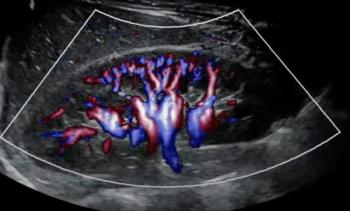
Sclerosing foam enhances varicose vein embolization
By combining microcoils with the injection of a foaming agent, U.S. interventional radiologists hope to treat testicular atrophy in young boys, reverse infertility in some men, and relieve a potentially disabling condition in women.
By combining microcoils with the injection of a foaming agent, U.S. interventional radiologists hope to treat testicular atrophy in young boys, reverse infertility in some men, and relieve a potentially disabling condition in women. IRs in Canada and Europe have used this embolization approach for some time. Several issues, including reimbursement, have delayed its U.S. inception.
The procedure uses sodium tetradecyl sulfate, or STS, to seal off abnormally engorged varicose veins in the scrotum that cause testicular pain and gonadal atrophy. The goal is the same in female patients whose enlarged veins lead to abnormal blood pooling in the pelvic cavity, causing random but progressively incapacitating pain.
Dr. Robert I. White Jr., an interventional radiologist at Yale University, reported at the 2006 Society of Interventional Radiology meeting about 20 men with varicoceles and 10 women with pelvic congestion syndrome who had achieved successful embolotherapy. The procedure involves the deployment of fibered coils only in larger areas of the internal spermatic and ovarian veins.
A contrast-enhanced venogram is performed to light up small collateral vessels that were unreachable by previous methods. STS is then injected to close those vessels and prevent recurrence. Leaving the main access vein patent makes future access much easier if repeated treatment is necessary.
A study published by researchers in the Netherlands found that varicocele embolization in infertile men significantly improved semen production (Fertil Steril 2004;81[6]:1679-1683).
Pelvic congestion syndrome can be difficult to detect because lying down during an exam relieves blood pressure from veins. Many women with the syndrome have gone years without a definitive diagnosis and, consequently, no relief from pain. Current diagnostic imaging advances and embolotherapy have reversed this situation, White said.
Accumulating studies should support the trend, said Dr. Robert Worthington-Kirsch, an interventional radiologist at Image Guided Surgery Associates in Philadelphia.
"Simply putting a catheter in the vein and throwing something in is no longer sufficient. You have to do something to address the abnormal vein bed and smaller vessels so they don't turn out to become a big problem later on. Dr White's study is a huge step in the right direction," Worthington-Kirsch said.
Although Worthington-Kirsch already performs these procedures, he warns they won't reach the mainstream public yet. In the case of pelvic congestion syndrome, for instance, many insurance companies refuse payment because they don't think it is a real or acceptable disease entity.
"As we get more data, we will be able to sort out what protocol works best. In turn, accumulating evidence in the clinical literature will turn reimbursement issues around," he said.
Newsletter
Stay at the forefront of radiology with the Diagnostic Imaging newsletter, delivering the latest news, clinical insights, and imaging advancements for today’s radiologists.




























